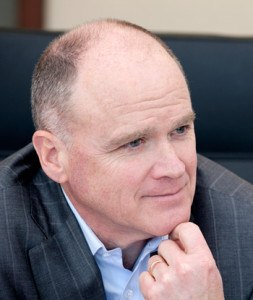 XL Group CEO Mike McGavick is standing firm against the push for insurers to divest from fossil fuel. He’s urging caution, even as those efforts continue.
XL Group CEO Mike McGavick is standing firm against the push for insurers to divest from fossil fuel. He’s urging caution, even as those efforts continue.
“I hope we’re really thoughtful about the defunding effort,” McGavick said during, “Break in the Ice: Climate Risk and the Insurance Industry,” a conference held June 1 at the University of Washington.
Washington Insurance Commissioner Mike Kreidler and the University of Washington Climate Impacts Group held the event to raise awareness among insurers of the need to consider climate risks when providing insurance products to customers.
McGavick made his remarks during a talk he gave at the conference in which he used the word “defunding” in place of the more popular term, “divestment.”
Last year, Carrier Management noted McGavick’s opposition to divestiture during a session at the Global Insurance Forum of the International Insurance Society, where he said that “the idea that we’re going to divest in carbon is nonsense.” At the time, McGavick argued that it’s too large a part of the economy and reinsurers “would be failing our shareholders if we weren’t investing in a prudent way.”
He is considered proactive for his efforts to raise awareness of climate risks the insurance industry faces.

During the June 1 climate conference, McGavick clarified his position during follow-up questions, saying that a wholesale departure from fossil fuel investments is not a good idea, as he expects the private sector to play an important role in reaching the carbon reduction goals laid out in the Paris agreement.
Many big energy providers, most of which are on the target lists of those calling for divestiture, are contributing to scientific efforts to create innovations that will provide greener energy.
McGavick also argued that natural gas providers, many of which are also on the lists of those calling for divestments, have helped reduce carbon emissions.
The idea of regulators pressuring insurers out of certain investments has been opposed by insurance groups including the Property Casualty Insurers Association of America, which has argued the industry should be allowed to make its own judgment on what investments to make.
Getting insurers to rid themselves of investments in fossil fuels, creating products to deal with climate change and helping the world better understand risk, were among the topics at the June 1 conference. State and local businesses, representatives from the insurance industry, legislators, government representatives, academics, and environmental and consumer advocates attended or spoke at the half-day event, which was attended by several hundred people.
Getting insurers to divest from coal and other fossil fuels has been a hot topic lately.
California Insurance Commissioner Dave Jones earlier this year asked all insurance companies doing business in California to voluntarily divest from their investments in thermal coal. That followed a move by Henri de Castries, chairman and CEO of French insurer AXA, who announced in May 2015 that the company was ridding itself of investments in companies most exposed to coal-related activities.
Kreidler lately has expressed concern that insurers could have assets stranded if fossil fuel investments suddenly plummet, a scenario that might be pushed in part by the agreement between 200 hundred countries in Paris last year, the United Nations Climate Change Conference.
“As an insurance regulator, you want to be absolutely sure insurers portfolios aren’t in jeopardy in some fashion,” Kreidler said during the conference.
Material Risk
Alex Bernhardt, a principal with consulting firm Mercer, talked about the increased dangers of investing in carbon-based activities and revisited a report his firm released last year, “Investing in a Time of Climate Change,” that looks at climate change estimates representing 2, 3 and 4 degrees Celsius warming scenarios.
The report shows the average annual returns from the coal sub-sector could fall by between 18 percent and 74 percent over the next 35 years and between 26 percent and 138 percent over the next 10 years.
“We think climate change is a material risk which all investors need to pay attention to,” Bernhardt said.
Bernhardt was also involved with a report out in late May from Ceres, a Boston, Mass.-based nonprofit group that advocates for sustainability leadership. This report said that thetop U.S. insurers have nearly half-a-trillion dollars invested the fossil fuel energy and the electric and gas utility sectors.
That Ceres report urged state insurance regulators and board members of these companies to help move them out of such investments.
The 200 countries that came together to sign the Paris agreement last year sent a “clear signal” about the intent to reduce carbon emissions, said Stephen Scofield, director of financial industry solutions in North America for the South Pole Group, an international company that specializes in reducing greenhouse gases.
“That’s a very, very strong signal to the business community, and to the investment community,” he added.
Underinsured Risks
Alex Kaplan, senior vice president in global partnerships with Swiss Re, participated in a reinsurer panel at the conference.
Because Swiss Re insures risk globally, “climate change is very important to us,” Kaplan said.
He expressed concern there’s a “massive accumulation” of risks in exposed areas, citing massive building booms in places like Shanghai, where insurance penetration is low, and the large number of high-dollar homes going up around bodies of water in the U.S.
In the U.S., the federal government frequently ends up footing the bill when catastrophe strikes these risky, often underinsured, areas, he said. Since 2005, U.S. taxpayers have spent $300 billion helping communities recover from extreme weather and fire alone, according to Kaplan, who said the solution is that “these people are going to have to own their risk.”
Risk-based Pricing
McGavick in his talk said the insurance industry needs to be able to price to reflect risk, which is hard to do with the government subsidies like those in the National Flood Insurance Program, which is billions of dollars in debt. Critics of the program have complained that it subsidizes flood-prone areas like Florida, where the risk of flooding is high, at the expense of other states.
“We’re not sending the signal that causes the right economic behavior,” McGavick said.
A joint statement was sent out by several insurer groups on Wednesday in response to the conference.
The statement was attributed to the American Insurance Association, the National Association of Mutual Insurance Companies, the Northwest Insurance Council and the Property Casualty Insurers Association of America.
 “The property/casualty insurance industry is committed to helping policyholders and communities in every region to prepare, prevent and recover from damage caused by extreme weather,” the statement reads. “Insurers share the concerns about reducing the economic impacts of recurring extreme weather. Insurers also have an acute interest in reducing damage to homes, businesses and communities.”
“The property/casualty insurance industry is committed to helping policyholders and communities in every region to prepare, prevent and recover from damage caused by extreme weather,” the statement reads. “Insurers share the concerns about reducing the economic impacts of recurring extreme weather. Insurers also have an acute interest in reducing damage to homes, businesses and communities.”
The statement outlines efforts by insurers to work with policyholders to encourage mitigation, as well as partnerships with local, state and national firefighting and emergency management organizations.
It further outlines goals to identify better ways to prepare for and recover from extreme weather events, which include encouraging states and communities to adopt stricter land use measures and strong building codes, supporting and research and incentives (tax credits, loans, grants) to promote loss mitigation, sharing science-based information to better inform decision-making and undertaking evaluations of risks related to climate activity.
The last goal on the list “includes vigorous risk management discipline across insurer investment portfolios, which includes enterprise risk management and stress-test analyses to properly assess the risk of all invested assets.”
*A version of this story appeared previously in our sister publication Insurance Journal.





















 Underwriter, Actuary Fears of AI Drop; Work Needed on Collaboration
Underwriter, Actuary Fears of AI Drop; Work Needed on Collaboration  Berkshire Hathaway Enters Post-Buffett Era as Share Prices Fall
Berkshire Hathaway Enters Post-Buffett Era as Share Prices Fall  Why ‘Good Enough’ Is Killing Insurance: The Hidden Cost of Satisficing
Why ‘Good Enough’ Is Killing Insurance: The Hidden Cost of Satisficing  Is the AI Boom a Bubble Waiting to Pop? Here’s What History Says
Is the AI Boom a Bubble Waiting to Pop? Here’s What History Says 












